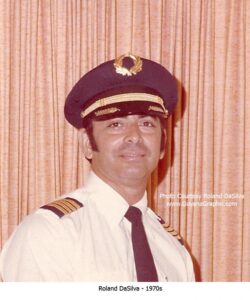
Roland DaSilva was born on November 27, 1936 the firstborn of four sons to Gaston DaSilva who was a first-generation Guyanese of Portuguese descent, and Angelina Mekdeci who was born in New York, USA, of Lebanese parents, who moved to British Guiana via New York and Cayenne, French Guiana.
Roland’s father Gaston managed the Polar Bear rum shop at the corner of Regent and Light Street, inherited from his parents. Roland was the eldest of four sons that included Michael (deceased), David a physiotherapist in Vancouver, Canada and Peter in Naples, Florida who is a captain for USAir.
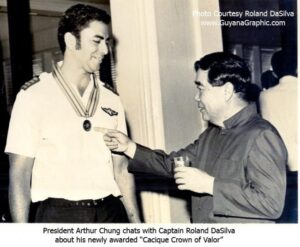
Roland attended St. Mary’s Roman Catholic School on the corner of Brickdam and Camp Streets, opposite the Cathedral of Immaculate Conception (Brickdam Cathedral), and then on to Central High School on Smythe Street. Roland excelled at cycle racing and became the Georgetown High School Champion, eventually moving on to motor racing.
Roland showed keen interest in flying at an early age often spending much of his time reading about airplanes and building models that he flew at the sea wall. When Roland was 18 his dad decided to buy a four-seater Auster Mk 5 British Built aircraft; registration VP-GAM, from Booker Sugar Estate and they engaged the services of John Rix as the instructor; Roland’s first flight was on December 30, 1954.
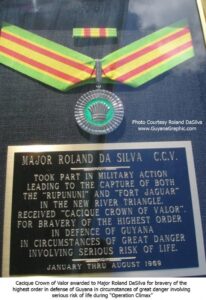
After seven hours Roland performed his first solo flight accompanied by British Guiana Airways Captain Julian Pieniazek (Czechoslovakian). His final check ride was with Alec Phillips the then Director of Civil Aviation (DCA) and he was issued his pilot’s license; PPL #14, on March 21, 1955.
Roland’s father then sent him to Britain’s Air University in Hamble, Southampton where he obtained his commercial and instrument rating license; CPL #26, issued on 7/15/1957.
While in England, Roland met and married his first wife who was an employee at the school, and she moved with him to Guyana at the end of his training, traveling on one of the Booker ships. The marriage resulted in the birth of two girls, Lisa and Paula, they were ages 10 and 6 when they migrated to the USA with their mother.
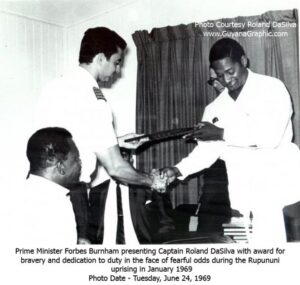
On his return to British Guiana, Roland started flying at the Demerara Light Airplane Flying Club. On a few occasions Roland and one of his friends would fly to and land on 63 Beach. He would offer sightseeing rides around the area for $5.00 per person and a friend of his would organize the passengers and go to the local gas station to purchase automobile fuel for the aircraft.
Roland was then recruited by Joe Vieira, his uncle, to fly the first aircraft purchased by a Guyanese, a Cessna 172 registration VP-GAX from Kansas, USA, to British Guiana. The aircraft took off on May 28, 1958, and arrived at Atkinson Field on June 06, 1958. Joe Vieira was married to one of Roland’s aunts (his mother’s sister) and his father was a gold miner who worked in the interior. He used much of his fortune to purchase land which became known as the Houston estate. This is significant because many might not remember that during the 1960-1970 Georgetown expansion to its current perimeters, the government at that time had to purchase land from Vieira’s Houston estate.
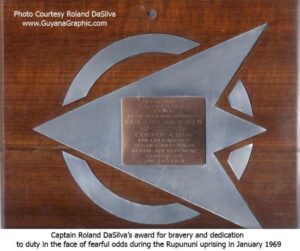
In September 1957 Roland became the first Guyanese to join British Guiana Airways. His first training flight, aircraft registration VP-GAG, was on September 9th with Chief Pilot Johnny Wilson. In October 1961 he became the first Guyanese to hold a commercial and instruments rating pilot’s license and the first Guyanese to qualify as a captain on a DC3 with ALTP # 35 issued October 16, 1961. Roland shared a number of stories that paint a picture of a man always striving for excellence.
Just a Lady in the Crowd
One of the first memories Roland shared was about a prank held at the Demerara Light Airplane Club air show. Roland dressed as woman and stood within the crowd pretending to be another onlooker. Alex Phillips, the Director of Civil Aviation (DCA), selected Roland – “the woman” – from the crowd to be taken up for her first joy ride in an airplane. With Alex Phillips and Roland – “the woman” – in front of the airplane and Pilot in the back seat and the airplane idling with the wheels chocked, Alex left the airplane to go to the hanger to pick up something only to find that the airplane with “the woman” in the front seat suddenly taking off with full power. The airplane wobbled down the runway, took off, then buzzed the crowd and returned for a landing with the crowd scattering for cover.
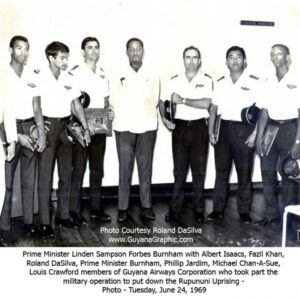
Prime Minister Linden Forbes Sampson Burnham and members of Guyana Airways Corporation
L-R – Albert Isaacs, Fazil Khan, Roland DaSilva, Prime Minister Burnham, Phillip Jardim, Michael Chan-A-Sue, Louis Crawford
Emergency Landing in the Jungle
Another of Roland’s memories was when he flew for Joe Tesarek during October 1955 using his aircraft Auster-5. Roland departed Orinduik for Velgrad late that evening, he was scud running below the clouds as the weather was bad, unable to land at Velgrad and decided to return to Orinduik only to find he was closed in. Roland was about 300 feet above the trees and did not want to climb into the clouds because of the high mountains in the area and it was getting darker. He had to land somewhere because there was no other choice, so he found a small clearing in the jungle of trees and somehow was able to land. Sometime later while sitting in the plane there were some Amerindians who came up to the plane and they stayed with him that night. The next morning he asked them to clear the small shrubs and trees so he could get out and they did. To thank them, he off loaded the cargo leaving it with them, as it was all food supplies for the people at Velgrad. He analyzed the clearing, decided which direction was best for the take off to head back to Orinduik, and made it out by the seat of his pants if you know what I mean.
Vulture Strike
During one of the routine trips to the interior and on approach to Lethem in the DC-3 registration VP-GAG with Captain John P. Wilson at the controls, the aircraft struck a large vulture which smashed through the windshield. Captain Wilson sustained a nasty cut over his eye and was temporarily blinded by the blood and incapacitated. Roland DaSilva as the copilot promptly took control of the aircraft and landed the plane safely without further incident. Captain Wilson received medical treatment at the Lethem dispensary and Roland later flew back to Atkinson Field from the copilot’s position with a temporary fix to the damaged windshield and a bandaged Captain Wilson in the left hand seat.
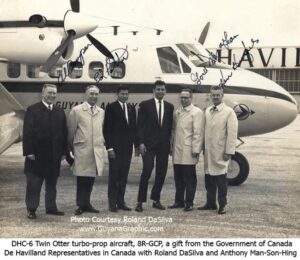
First Twin Otter flight to Guyana
After Guyana’s Independence in 1966 the government of Canada via CIDA (Canadian International Development Agency) offered assistance to improve Guyana’s aviation capability. Part of that assistance was to provide two DHC-6 Twin Otters, two DHC-4 Caribous and a state of the art hangar and maintenance facility at Timehri. The first aircraft 8R-GCP, a 19 seater De Havilland manufactured aircraft, the most modern in Guyana’s fleet at that time, left Canada on Sunday May 7, 1967 with stops in Detroit, Tallahassee, Miami, Nassau, Puerto Rico and Trinidad. The aircraft was flown by Captain Roland DaSilva and Co-pilot Anthony Man-Son-Hing. They were accompanied by De Havilland Aircraft Company technical representative Mr. Robert J. Griffin. Mr. Griffin was deployed to Guyana for three months to train local Guyanese engineers. Captain DaSilva and Co-pilot Man-Son-Hing were in Canada for type rated training two weeks prior to the aircraft’s departure for Guyana. The aircraft arrived in Guyana on Tuesday May 9, 1967 and signaled a new era of aviation for Guyana Airways Corporation.
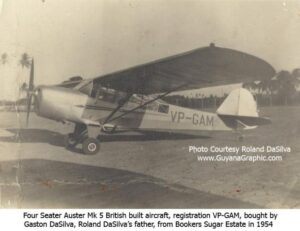
The Rupununi Uprising
On Thursday January 2, 1969 during one of his routine trips to the Rupununi area after takeoff from Lethem with a DC-3 registration VP-GAF, Roland intercepted a radio transmission from a missionary aircraft. It was reported that there was a group of people “shooting up” the Police Station at Lethem. At that time Roland was still flying over the Rupununi savannahs and observed a few of the airstrips in the area were blocked (Good Hope, Karasabai, Karanambo and Annai). He immediately placed a call to Georgetown flight operations and relayed his observation along with the information from the intercepted radio transmission. As relayed b Roland, “Georgetown contacted their agent at Lethem who responded that all was quiet at Lethem, this information was then relayed to me. However, I felt that because of the blocked airstrips that there must be something amiss. After further discussion with Georgetown, Malcolm Chan-A-Sue on VR-GAG who was flying in the Southern Rupununi area was advised by the Georgetown ground station to fly directly to Atkinson Field.
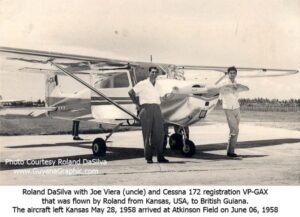
Roland DaSilva with his uncle Joe Viera and Cessna 172 registration VP-GAX that was flown from Kansa, USA to British Guiana. The aircraft left Kasnas May 2, 1958 and arrived at Atkinson Field on June 6, 1958
A group of Guyana Defense Force soldiers and members of the Guyana Police Force were assembled at Atkinson Field and they were flown back to Lethem. 8R-GAF piloted by myself, 8R-GAG piloted by Michael Chan-A-Sue and 8R-GAS piloted by Jardim.
We had to use the only available strip which was Manari, because the other Rupununi airstrips including Lethem, were blocked. On arrival at Manari, we encountered civilians fleeing their homes in Lethem and assembled at Manari. The fleeing civilians were evacuated to Georgetown to safety and relocated after the uprising was quashed. During the next 18 hours we flew reinforcements and supplies for the policemen and soldiers assembled at Manari in preparation for the ground assault on Lethem.
The next day as the reinforcements headed towards Lethem, and during the assault by the police and soldiers some of the insurgents managed to escape to Venezuela, while others were captured and held for transport to Georgetown. At the end of the operation it was discovered that during the initial attack on the Rupununi outposts five policemen and one civilian were killed, several others were injured and many were held hostage by the insurgents. The injured were transported to Georgetown for medical attention along with the captured rebels to face trials. Several months later during a court hearing in Georgetown we learned that the Lethem agent who had originally reported that all was quiet in Lethem was actually being held at gunpoint by the rebels and forced to respond to Georgetown’s radio inquiry that there was no problem at Lethem.
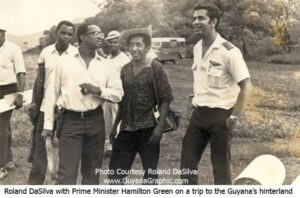
I also learned that while passengers were boarding my aircraft and preparing for takeoff the same rebels who held the agent at gunpoint (the Hart‘s, the Melville Brothers and Teserek) were at the back of the agent’s office trying to decide whether to prevent me from leaving or wait and capture the inbound DC3 flown by Malcolm Chan-A-Sue that was scheduled to arrive. Their decision proved costly for them and beneficial for us.
The Rupununi uprising proved to be one of the two most serious threats to Guyana’s sovereignty and territorial integrity and was thwarted by some of Guyana’s finest citizens.”
Rupununi Uprising Award
On Tuesday, June 24, 1969 Prime Minister Forbes Burnham presented awards to Roland DaSilva and five other pilots of Guyana Airways Corporation. The awards were for their bravery and dedication to duty in the face of fearful odds during the Rupununi uprising in January 1969. The awards consisted of plaques of polished purpleheart wood with the insignia of the GAC Logo inlaid in polished anodized aluminum. The other awardees were Albert Isaacs, Fazil Khan, Phillip Jardim, Michael Chan-A-Sue, and Louis Crawford.
Retaking of the New River Triangle, “Operation Climax”
In 1969 it was discovered that The New River Triangle area was illegally occupied by Surinamese troops who set up a camp they named “Tigri”. This illegal occupation of Guyanese territory was detected by routine surveillance flights carried out by the Guyana Defence Force Air-Wing.
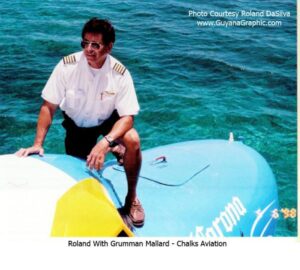
Roland with Grumand Mallard – Chalks Aviation
This change of tactic was after years of both Guyanese and Surinamese forces maintaining camps on opposite sides of the New River which separates Suriname and Guyana in the southeastern most border of Guyana. During the “stand-off” both sides monitored each other’s movements while the politicians used diplomatic channels to squelch Suriname’s claim to Guyana’s territory, a long-ago resolved territorial dispute.
Then Prime Minister Forbes Burnham requested the presence of Colonel Clarence Price of the GDF and me (Roland DaSilva) for a strategy meeting to develop a plan for the ousting of the occupiers. The plan code-named “Operation Climax” was developed and the actions were set into motion.
Roland continues; “Several plans were mulled over and rejected, including approach from the river or land because of the difficult terrain and the Surinamese control of the river. During this period Guyana did not have any helicopters in its inventory but in my role as Chief Pilot of Guyana Airways I was convinced that an assault could be made on the unfinished airstrip using the STOL capabilities of the Twin Otters. The timing of the raid had to coincide with the stage at which the Surinamese would have completed the first three hundred meters of the airstrip.
I selected the pilots to take part in this operation; Philip Jardin, Michael Chan-A-Sue, Tony Mekdeci. Part of the plan was to install in the DHC-6 Twin Otter that was leading the assault and flown by me and Michael Chan-A-Sue, a machine gun installed by George Loy and mounted in the nose, and a smoke flare in each wing. The idea behind the smoke flares was in the event we got overhead and the strip was in a situation where I couldn’t land, I planned to pull a flare and give the impression that the airplane was having a problem – one engine was on fire – and they (hostile troops) would hopefully clear the area for me to land. Luckily I never had to use that ruse. To save on weight and to facilitate the rapid evacuation of 22 troops and equipment the doors were removed from each aircraft. The final decision for the assault was placed in the hands of the pilots and they were all commissioned into the Guyana Defence Force as Majors. The assault troops were divided into two handpicked groups, led by Captain Martin Nascimeto and trained at Takama Battle School where both pilots and troops practiced simulated short field landings and assault maneuvers. Surveillance of the occupied areas was carried out by Helio Courier aircraft and information garnered was relayed to the school for incorporation into the training. The surveillance allowed us to track the progress of the runway being built by Surinamese troops and it was noticed what appeared to be several 45 gallon drums were strategically placed on the runway to prevent the landing of aircraft. During our intense and realistic simulated assault training we discovered that the propellers of the twin otter were so high off the ground that even standing up, the drums were 8-12 inches below the tips of the propellers and therefore posed no problems during simulated landings. Also from our training and testing we were able to out-perform the De Havilland’s short field performance of the Twin Otter.
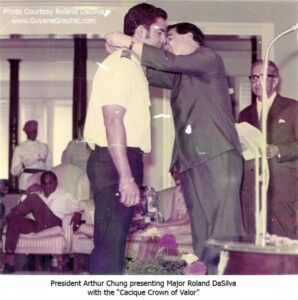
As we planned the New River military operations and began implementation it became clear that this was a life or death proposition and Philip Jardim and I went to Prime Minister Burnham and made our case that in the event of our deaths we would be leaving our family with nothing. We had been commissioned as Majors into the GDF, but that provided no financial support in the event of our demise. Prime Minister Burnham wrote a letter giving each one of us the assurance that in the event of our death our families would be taken care of. Mr. Burnham gave us the letters but at the time we didn’t know what was in them because they were only to be opened upon our death. We never saw the contents because we were fortunate to survive and returned the unopened envelope to the Prime Minister.
On August 18, 1969 44 troops and equipment were positioned at Apoteri which was approximately 90 miles from the New River triangle to prepare for the assault on the occupation forces at Camp Tigri. At pre-dawn on 19 August 1969, a Guyana Defence Force (GDF) Helio Courier reconnaissance aircraft took off from Apoteri airstrip to provide weather and other critical information to the assault team assembled at Apoteri. At around 5:30 am two modified De Havilland DHC-6 Twin Otter utility aircraft of the Guyana Airways Corporation’s (GAC) fleet took off with 22 armed soldiers on board each aircraft. The lead aircraft was piloted by me and Major Michael Chan-A-Sue with Warrant Officer Hartley Liverpool from the GDF manning the machine gun in the nose, and the second aircraft was piloted by Majors Philip Jardim and Anthony Mekdeci.
We started descent approach at 7,000 ft from the East using the sun and smoke from the burning bush fire as cover, and low engine power so as to minimize the noise. Once we committed to landing there was no turning back. As we were on final approach for the runway clearing, we noticed geological poles lining the runway that the camera from the surveillance aircraft did not pick up. Reverse power was applied in the landing flare and I positioned the nose wheel to knock over the poles. The troops exited the aircraft on the landing roll which was uphill and Suriname troops appeared on the rise and the sound of machine gun fire mixed with the sound of the Twin Otters’ PT-6 engines shattered the quiet of the morning. Warrant Officer Hartley Liverpool opened fire along with the other members of the landing party sending the Surinamese troops scurrying into the jungle. A total of 44 troops were on the ground at Tigri in about 5-6 minutes, by 2 Twin Otters, only about 600 feet of airstrip was available for this operation.
I turned the aircraft in the direction of landing and on roll out with troops still disembarking inadvertently ran over the foot of Captain Nascimento, but because of the wide balloon tire of the Twin Otter no permanent damage was done. I powered up the aircraft for takeoff as the last person exited making room for the second aircraft while the first assault group chased the occupiers into the jungle.
The second aircraft landed and the troops disembarked on the landing roll and took off observing the ground activity from a safe distance. Our dawn raid surprised the Surinamese troops many of whom were at breakfast and not expecting an aircraft landing in the small clearing. Once the GDF recaptured the area, outposts were positioned in three places one at each end of the clearing and one in the center.
Subsequent to the capture of Camp Tigri it was promptly renamed Camp Jaguar by the Guyanese troops. About half a dozen enemy troops were captured while others ran into the jungle and disappeared. The prisoners were later flown back to Suriname by KLM Airlines.
After the Surinamese troops were rousted from the New River Triangle area, the government of Guyana decided to establish a viable airstrip building on what was started by the Surinamese. A bulldozer was abandoned by the fleeing Surinamese troops, but additional equipment was needed for the project. It wasn’t feasible to get heavy equipment by the river because of Surinamese troops occupying the river and no helicopter availability. It was decided that a DC3 was required to get the much needed heavy equipment to the area. Using the abandoned Surinamese bulldozer the airstrip was extended to 2000ft,, additional heavy equipment was disassembled and loaded onto the DC3 and myself and the co-pilot Shrimpy Meertins flew in, crossing the river from the west where the trees had been cleared, then taking off in the opposite direction. The landing was quite hairy and we never returned until the airstrip was completed.”
Cacique Crown of Valor award
For his faultless planning and execution of Operation Climax, Roland was informed by letter from President Arthur Chung dated May 22, 1970 about his investiture with the Cacique’s Crown of Valor to be awarded on May 26, 1970, the fourth anniversary of Guyana’s independence.
The inaugural investiture of Captain Roland DaSilva by Guyana’s first President Mr. Arthur Chung, with the Cacique’s Crown of Valor was held on February 23, 1971, the first anniversary of the Cooperative Republic of Guyana. The inaugural investiture was held at Guyana House Georgetown, Guyana.
Roland DaSilva became the first and only Guyanese to have received Guyana’s highest award the “Cacique’s Crown of Valour” for bravery of the highest order in defense of Guyana in circumstances of great danger involving serious risk of life. The award was bestowed upon Captain Roland DaSilva Guyana Airways Corporation Operations Manager and Chief Pilot for the military mission flown during the Rupununi uprising in January 1969 and the retaking of Guyanese territory from Suriname at Camp Jaguar, New River Triangle in August 19, 1969.
The Golden Arrow of Courage was awarded to Captain Michael Eugene Chan-A-Sue, Captain Philip Desmond Jardim and Corporal Looknaut Singh of the Aurora Police Station for bravery of a high order in defence of Guyana.
Beechcraft Super King Air B200 executive aircraft
In his own words: “When the then Prime Minster of Guyana Forbes Burnham decided to buy an executive aircraft, he selected the Beechcraft Super King Air (B200) registration 8R-GFB, and I along with Michael Chan-A-Sue and a select group were sent to the US for training on the aircraft. I was certified September 17, 1975 and performed numerous national and international flights for the Prime Minister and his delegation.”
First crash of Guyana Airways Aircraft
During a routine flight to the Kamarang area the first registered Twin Otter in Guyana, 8R- GCP was being flown with Captain Walter Danraj and co-pilot Frank Watson, a passenger, and third crew Compton DaSilva (no relative of Roland). They were apparently flying in low clouds and crashed into the top of a mountain in the Kamarang area, killing the pilot, co-pilot and passenger with the third crew member as the only survivor. After an extensive search effort over the course of three days the wreckage was spotted by Captain Philip Jardim who was alerted of the location when the survivor fired a flare. The Embassy of the United States in Georgetown was contacted and they summoned the assistance of a helicopter that was flown to the area and performed the rescue of the survivor. The aircraft was completely destroyed and was later replaced .
Grumman goose landing in the Demerara River with the wheels down
On a flight from Mackenzie in the Upper Demerara River, the Grumman Goose registration VR-GAU, with Captain John Wilson Chief Pilot of British Guiana Airways at the controls and no copilot or aircraft loader flipped over on landing at the Ruimveldt ramp. It became apparent that after take-off from the runway at Mackenzie the wheels were inadvertently left extended and created drag during the water landing causing the aircraft to flip over. The aircraft was completely demolished but the occupants survived.
Grumman Goose – Broken Trim Tab
The Grumman Goose was used on interior passenger and cargo trips from the Ruimveldt Ramp in Demerara River to Turmereng in the Kamarang area, once or twice a week.
After landing at Tumereng on a routine flight, the copilot on that day Albert Isaac now in Canada was performing the pre-flight check and noticed that the trim tab on the elevator was broken and hanging.
After our discussion I decided that I was going to fly the aircraft back to Ruimveldt. He asked how we were planning to trim the aircraft and I responded that we would use the bags and passengers to trim the aircraft for flight. We discussed the procedure and identified what was needed and his role in accomplishing the goal of trimming the aircraft for take-off, flight and landing. I took off, he instructed the appropriate passenger(s) and bags as necessary to trim the aircraft for flight and did the same for landing, and we made it safely all the way home.
Supporting Elections by collecting Ballot Boxes from outlying areas
During one of the general elections, the military was tasked with retrieving ballot boxes from outlying areas using the twin otters. The opposition of the time had their supporters block roads and landing areas to prevent uplifting of the ballot boxes in the Courantyne area. The government ordered the Guyana Airways Aircraft to collect the boxes after the closing of the polling stations. This entailed flying in at the dead of night to outlying areas, landing on roads using vehicles and other makeshift devices to mark out landing areas. The ballot boxes were then offloaded at Ogle Airport into the hands of the authorized personnel of Guyana Defence Force for safekeeping.
On one of the trips to the Rose Hall area, on approach to the makeshift landing area on one of the local roads, I observed what appeared to be the landing area but at about 200 ft discovered that it was the canal beside the road that was reflecting the lights from the local area, I then made an adjustment and landed on the road without further incident.
In another incident on approach to another makeshift landing are at Uitvulgt I noticed just before touchdown that there was a large tree that was close to the touchdown point and I had to perform an evasive action to avoid the left wing of the aircraft from striking the tree.
Move to the USA
Roland met his current wife Jenny Gomes and they were married in 1977 and migrated to the USA in the same year. This union resulted in the birth of Tina and Roland Jr. who currently live in Florida.
Roland began working for Argosy Airlines flying a DC3. The aircraft had many maintenance issues e.g. excessive oil consumption, along with engine failures, but provided Roland with the opportunity to gain a foothold in aviation in the USA. The owner of Argosy Airlines was also one of the Captains, with his wife as flight attendant and on one trip to Cuba they crashed killing them both, but by this time Roland had moved on to another Airline.
Walkers International
Roland began flying for Walkers International in 1978 flying DHC-6 Twin Otters. The owner was the inventor of the aerosol valve found on the top of spray cans and he owned the northern most island in the Bahamas called Walkers Cay. On the island there was a hotel and a marina for those interested in offshore fishing. Most of the flights traversed between Walkers Cay and a facility Walkers owned at Ft Lauderdale International.
Walker’s Cay incident
In his own words: “I was in command of a DHC-6 Twin Otter flying into Walker‘s Cay, I arrived at the terminal at around 1 pm with departure scheduled for 5 pm for our flight to Ft. Lauderdale. It was hurricane season and there were heavy winds. The airplane was loaded with 17 passengers the wind was about 25 mph gusting out of the south I taxied to the end of the runway, lined up and took off heading in an easterly direction then turning on course heading west, I suddenly lost elevator control, I pulled back on the column but nothing happened. I called the station at Walkers Cay and told them it seemed I might have to ditch since there was no elevator control. I decided to use the trim tab and the power to bring the aircraft around, lined up with the runway just flying with the trim tab and power got about 5 feet over the runway and coming in fast, I had to wait for the speed to decay. I thought I was going to run out of runway the runway was approx., 2000 feet so I put the propellers in beta range, so I could place the propellers into zero pitch for use as an airbrake. The plane hit the runway and I placed it into reverse and came to a stop. The passengers were never made aware of the situation to avoid panic, and the chance they might move around in that panic and cause more distress to the aircraft that could have caused us to land in the ocean. On inspection we found that the problem with the elevator was that De Havilland had sent out a NOTAM saying that there were instances of elevator bell crank failure beneath the floor and they should be inspected and replaced. In this case when maintenance checked the aircraft they did not find cracks and so made the decision not to replace the bell crank at that time. Because the airplane was sitting in the Bahamas and the winds had been battering the plane around even with locked controls, the bell crank failed a short time after take-off. The bell crank was replaced and the airplane was returned to service.”
This incident was so unusual that it is highlighted to flight students at De Havilland of Canada by Guyanese born Flight Instructor Albert Isaacs. He also cites that pilots today are trained by simulators and very little actual flying of aircraft. He also brought up the Tumereng incident as an example of how important it is for pilots to have real hands on training and not so much emphasis on simulator and computer training, in order to be able to handle incidents of that nature.
Chalks Aviation
Roland left Walkers Cay 1996.and joined Chalks Aviation, flying Mallards. During his tenure on a trip carrying guests to a wedding, Roland donned his captain’s uniform and with several guests in the lounge pretended that he was blind. Wearing large dark glasses and a white cane, Roland bumped into the glass exit door, and had to be assisted by the copilot who led him to the aircraft. The flight attendant then announced to the passengers that the flight was ready to leave, with the captain in at the controls. As you can imagine no passenger got up to board the aircraft claiming that they were not going with a blind pilot. Roland then returned to the terminal and revealed that it was a joke and everyone happily boarded for their destination. A few days later at the pick up of the wedding party, some of the passengers played their own prank on Roland by pretending to be blind.
Roland left Chalks in 2004 and rejoined Walkers Cay flying their Mallard out of White Plains NY while still living in Florida. He would fly up from Fort Lauderdale for three months during the summer and fly between White Plains and the owner’s Saranac lake log house. He would spend three weeks in New York and return home for one week and did that until the end of his three month tour of duty and then fly the aircraft back to Fort Lauderdale.
After 9/11 Chalks was no longer allowed to land near Watson Island because of the possible threat to the cruise ships. During its operation in and out of the harbor of Miami, the aircraft had no special privileges to land in the harbor, and sometime the jet skis riders would line up beside the aircraft on takeoff.
Roland’s last flight flying the Mallard for Chalks was December 1999 to a surprise tumultuous water canon salute. On his final flight into Fort Lauderdale International Roland noticed that the fire trucks were sitting at the end of the runway and wondered if there was an accident or if they were waiting for an expected emergency. As he approached the taxiway the 2 fire trucks were positioned on either side of the taxi way and water cannons opened up; streams of water soared into the sky, bringing to close an illustrious career of a true Guyanese and international hero.
Roland’s flying career was from 1953-2006, a total of 49 years with 36,151 flying hours.
Roland had a number of firsts:
- First Guyanese to join British Guiana Airways as a pilot
- First Guyanese to hold a commercial license
- First Guyanese to qualify as a captain on a DC3
- First Guyanese along with Tony Man-Son-Hing on the Twin Otter
- First and only Guyanese to be awarded The Cacique Crown of Valour
Roland was qualified captain of all Guyana Airways aircrafts and 2 Guyana Defense Force aircrafts during his tenure: Grumman Goose, DC3, DHC4 Caribou, DHC6 Twin Otter, HS-748, Beechcraft Super King Air, Cessna 310, All Guyana Defense Force aircraft, including BN Islanders and the Helio Courier
Roland credits his near perfect record to
“I always plan to ensure I have a way out of any situation.”
To quote Roland,
“Fear only exists when you have an alternative.”
Roland DaSilva, is a pioneer and hero. We hope his legacy can be acknowledged with an award that will provide international recognition of this accomplished Guyanese.






